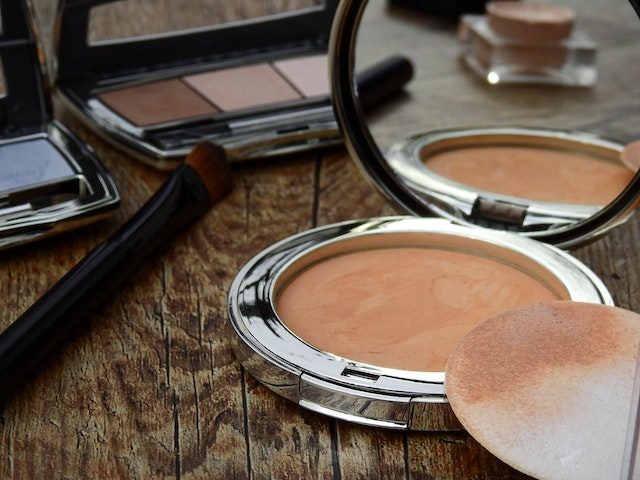Forever chemicals in cosmetics?
That doesn’t sound good.
Unfortunately, scientists found these potentially dangerous toxins in most of the cosmetic products they tested, according to a study published in Environmental Science & Technology Letters.
What’s going on here, and how can you make sure you’re not exposed?
What are Forever Chemicals?
So-called forever chemicals are a class of chemicals used to make products grease-proof, waterproof, stick-proof, and stain-resistant. Manufacturers add them to things like non-stick cookware (Teflon), firefighting foams, carpets, stain-proof and waterproof clothing, medical equipment, food packaging (pizza boxes and food wrappers), and more.
These chemicals have been dubbed “forever chemicals” because they are persistent in the environment and can last for thousands of years without breaking down. They can also persist in the human body and have been linked to a variety of health problems.
This class of per- and polyfluorinated alkyl substances (PFAS) includes over 4,700 man-made individual chemicals. Since 1999, the U.S. Centers for Disease Control and Prevention (CDC) has measured at least 12 PFAS in blood serum samples from participants 12 years and older. Scientists have found four of them in the blood of nearly all people tested, indicating that exposure is widespread across the U.S. population.
Four PFAS found in most humans:
- PFOS (perfluorooctane sulfonic acid)
- PFOA (perfluorooctanoic acid)
- PFHxS (perfluorohexane sulfonic acid)
- PFNA (perfluorononanoic acid)
Research in humans suggests that high levels of PFAS may increase the risk of the following health issues:
- Increased cholesterol levels
- Reproductive effects like decreased fertility or increased high blood pressure in pregnant women
- Increased risk of kidney, prostate, or testicular cancer
- Reduced ability of the immune system to fight infections
- Interference with hormones
How Are People Exposed to Forever Chemicals?
You may think, “But I don’t use nonstick cookware, so I’m not exposed to forever chemicals, right?”
Unfortunately, no. There are several ways that people can be exposed to these toxins.
How People Are Exposed to PFAS
- Drinking water contaminated with PFAS
- Working in occupations such as firefighting or chemicals manufacturing and processing
- Eating certain foods that may contain PFAS, including fish
- Swallowing contaminated soil or dust
- Breathing air containing PFAS
- Using products made with PFAS or that are packaged in materials containing PFAS
Unfortunately, according to the National Resources Defense Council (NRDC), PFAS are almost impossible to avoid. “They are found in our homes, our offices, our supermarkets—practically everywhere.”
The Clear Water Fund, however, offers a handy Shopper’s Guide to Avoiding PFAS, which includes recommendations of products to avoid as well as apps that can help you further identify ways to reduce your exposure.
Surprisingly to most of us, “personal care products” is on the Clear Water Fund’s list of products to potentially avoid. Specifically, be aware of those products that contain “perfluor” in the ingredient list, and products that are identified as long-lasting or waterproof, especially lipstick, mascara, and foundation.
Are There Forever Chemicals In Cosmetics?
Manufacturers may add PFAS to cosmetics to increase their durability and water resistance. Sometimes contamination with PFAS may occur too, and some PFAS can be residual, meaning that they are an ingredient within an ingredient.
Scientists from the University of Notre Dame and other universities in collaboration with the Green Science Policy Institute found PFAS in most of the cosmetics they tested.
To assess the potential health risks, they purchased 231 cosmetic products in the U.S. and Canada, then screened them for the presence of PFAS using particle-induced gamma-ray emission spectroscopy.
Of the eight categories tested, foundations, mascaras, and lip products had the highest proportion of products with PFAS. Worse, the majority of those products confirmed to have PFAS had no PFAS listed on the label.
Several other studies have found similar results. In 2022, scientists published the results of another experiment. They tested 38 cosmetics and personal care products and found a “predominant and ubiquitous” presence of polyfluoroalkyl phosphates (PAPs), which are known to degrade into perfluorocarboxylates (PFCAs)—a group of PFAS.
They found other PFAS too, including those previously measured in wastewater and those associated with firefighting foams (used at airports and military bases to put out gas-fueled fires).
“Overall,” the researchers wrote, “these data highlight that cosmetics and personal care products can contain a breadth of PFAS at extremely high levels, leading to human and environmental exposure.”
You may absorb these chemicals through the skin. You could even ingest them. Lipstick wearers could ingest up to several pounds of lipstick in their lifetimes, according to Arlene Blum, PH.D., founder and executive director of the Green Science Policy at the University of California in Berkeley.
These toxins can then make their way into our drinking water after they’re washed down the drain.

Forever Chemicals in Cosmetics: Consumers Deserve Better
As awareness of PFAS in cosmetics increases, consumers are demanding better. According to the U.S. Food and Drug Administration (FDA), between 2019 and 2020, manufacturers used about 21 types of PFAS used as ingredients in cosmetics.
Fifteen of these types decreased in overall use during that time, which is a good sign. The number of products containing at least one PFAS also decreased from 506 to 235.
Registration and product listing in the FDA’s Voluntary Cosmetic Registration Program (VCRP), however—a reporting system for manufacturers and distributors—is voluntary. So it’s likely the real numbers are higher than those reported.
Still, the trend is to get away from using potentially toxic ingredients in our personal care products and cosmetics. In 2021, Congress introduced the “No PFAS in Cosmetics Act” which would ban the use of intentionally added PFAS substances in cosmetics.
So far, the bill is still in limbo, but some states are taking the matter into their own hands. Laws and regulations restricting forever chemicals in more than half a dozen states went into effect in 2023, including the start of a timeline for a first-in-the-nation ban on PFAS in all products in Maine.
How to Avoid Forever Chemicals in Cosmetics
Using waterproof mascara now and then is unlikely to hurt you. The concern is when we use a PFAS-containing product over and over again day after day. That’s what we need to avoid to protect our health.
Steps you can take to reduce your exposure to forever chemicals in cosmetics include:
- Avoid water-resistant or waterproof products. If you do use them, use them only occasionally.
- Download Clearya, a free mobile app and browser plugin that automatically scans cosmetic ingredients as you shop online. At checkout, it notifies you of any unsafe ingredients, such as PFAS.
- Check your products against the Environmental Working Group’s (EWG’s) Skin Deep Guide to see what toxins they may contain.
- Check the Green Science Policy Institute’s list of PFAS-Free products.
- Shop for your skincare and cosmetics with conscientious brands that use only safe and non-toxic ingredients. CV Skinlabs is one of these brands!
- Remember that “natural” isn’t always “safe.” Don’t fall for fear-mongering—just shop wisely.
- Look for “clean beauty” brands when shopping in the personal care section, then double-check your products against the EWG’s Skin Deep Guide.
Do you try to avoid PFAS in your cosmetics?
Featured image courtesy of Sam Lion of Pexels.






